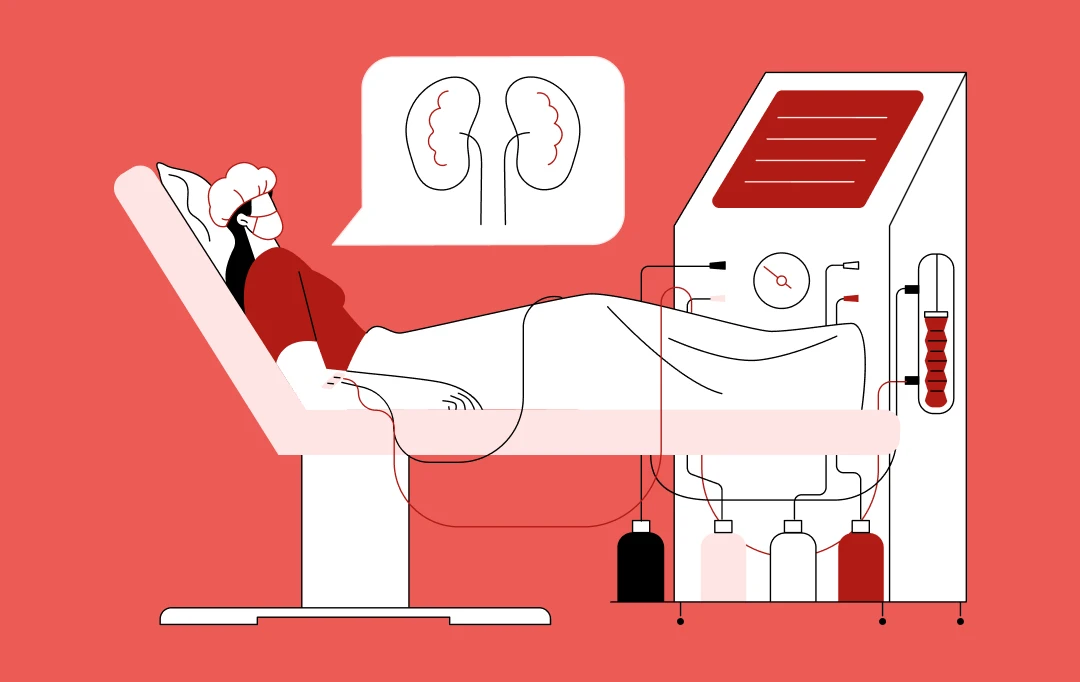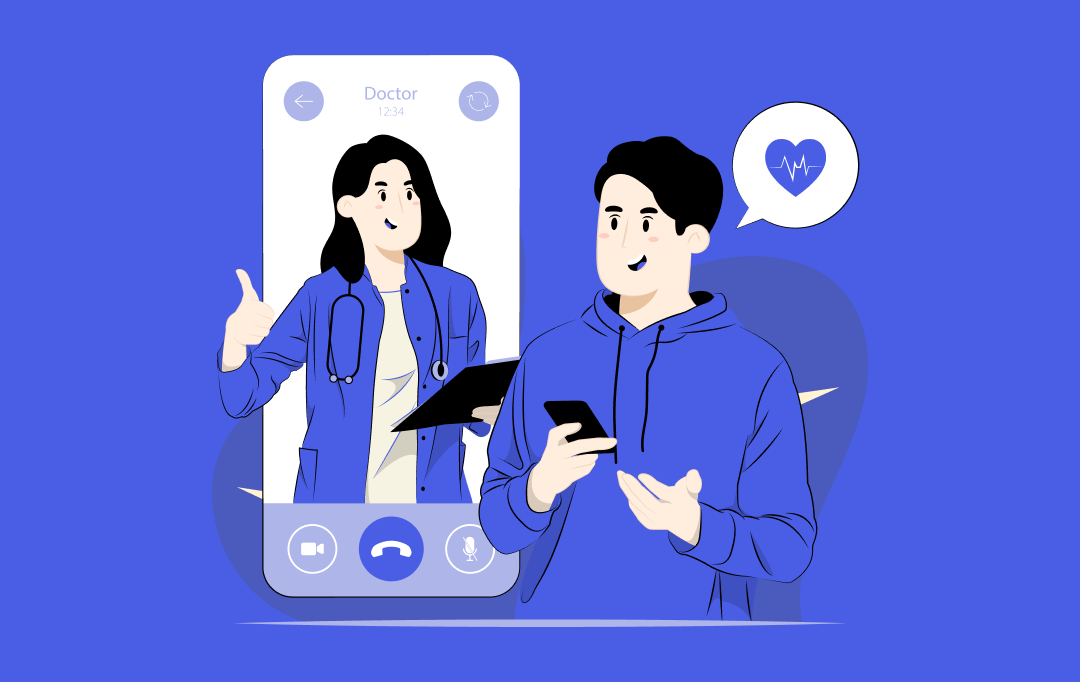- What is a Patient Engagement Software: A Quick Glimpse
- What types of healthcare organizations need patient engagement software?
- The Cost of Not Having Patient Engagement Technologies in Place
- Lowered patient flows
- Less preferable patient outcomes
- Increasing medical expenses
- The benefits of patient engagement in healthcare
- Benefits of patient engagement technology for healthcare systems
- Benefits of patient engagement software for patients
- The must-have features of patient experience software
- Digital patient intake forms
- Upload medical history
- Digital payments
- Appointment reminders
- Automated lab test reports
- Health record viewing
- Secure communication
- The best patient engagement technologies
- Advanced Technologies That Can Enhance Patient Engagement Solutions
- Types of patient engagement system for hospitals
- Off-the-shelf patient engagement software
- Content management system
- Custom-built patient engagement solutions
- How to measure the patient engagement software ROI?
- How Appinventiv can help you build custom patient engagement software?
- FAQs
If there is one industry that has always been slow to digitalization but was forced into it on a global scale, it’s healthcare. However, although a terrible blessing in disguise, the patients, around the globe, are benefitting massively from the movement. Especially, after patients demanding technology for provider communication for decades now.
This technology-led digitalization that the healthcare is now operating under has done wonders to the patient engagement software development market. What was once $22.7 billion in 2023 is now expected to reach $70.3 billion by the time we hit 2030, witnessing a CAGR of 17.7% from 2024 to 2030.

The concept of patient engagement platforms is opposed to what once used to be a conventional system where the doctors used to prescribe a treatment and patients either accepted them or ignored the suggestion, leading to 3 out of 10 patients feeling dissatisfied. Nowadays, using the patient engagement system, doctors are able to reach their patients in real-time, foresee deterioration in their conditions, and give them the right guidance in time.
This rise in the digital patient engagement platforms has also been an after-effect of the costs of not having one in place.
This blog will help you understand everything related to patient engagement software development and how it can transform healthcare practices for the better. With comprehensive insights into its benefits, you will learn how such platforms not only improve patient-doctor communication but also enhance overall healthcare efficiency and patient satisfaction.
What is a Patient Engagement Software: A Quick Glimpse
Patient engagement software is a digital tool designed to enhance the interaction between healthcare providers and patients. It streamlines various aspects of healthcare management, making processes like scheduling, communication, and payments more efficient. This type of software supports a range of functions, from simple appointment reminders to accessing medical records, all aimed at improving the overall patient experience.
The core purpose of patient engagement software is to facilitate better health outcomes by keeping patients informed and involved in their healthcare journeys. Features such as digital intake forms, telemedicine, and secure messaging allow patients to manage their health care more actively and conveniently. By integrating these tools, healthcare providers can deliver personalized care and maintain continuous communication with their patients.
Moreover, patient engagement software is beneficial for healthcare facilities as it helps reduce no-shows, optimizes appointment scheduling, and ensures that both patients and doctors have easy access to necessary health information. This not only helps in efficient healthcare delivery but also enhances patient satisfaction, which is crucial for the reputation and operation of healthcare services.
What types of healthcare organizations need patient engagement software?
Patient engagement software is essential for healthcare organizations aiming to improve communication, streamline operations, and enhance patient care quality. Various types of healthcare entities can benefit from implementing such systems, each using the software to meet unique needs and improve patient outcomes. Here are some key types of healthcare organizations that typically need patient engagement software:
Hospitals: Large medical facilities use patient engagement software to manage a vast number of patient interactions, from appointment scheduling to discharge processes. The software helps in reducing wait times and improving the overall patient experience across various departments.
Clinics: Smaller clinics benefit from patient engagement software by enhancing appointment scheduling, patient communication, and access to medical records, making healthcare more accessible and personalized for patients.
Specialty Care Practices: Organizations focusing on specific areas of medicine, such as dermatology or cardiology, use patient engagement software to provide tailored educational content and manage specialized treatment plans more effectively.
Community Health Centers: These centers serve large communities and need efficient ways to handle high patient volumes. Patient engagement software helps streamline processes and improve outreach efforts.
Rehabilitation Centers: These facilities utilize patient engagement software to track patient progress, schedule therapy sessions, and communicate effectively with patients and their families about ongoing care plans.
The Cost of Not Having Patient Engagement Technologies in Place
Unthought patient engagement approaches can have a negative impact on the healthcare sector and so will be in cases where you don’t have one at all. Let us look at some consequences of not having patient engagement programs.
Lowered patient flows
Today’s consumers expect businesses to predict their wants and customize their offerings accordingly, which leads to the patients expecting the same level of experience from their healthcare providers. And when the provider fails to offer it, they move to a healthcare clinic that would, thus leading to lowered patient flow for the former. The secret to maintaining the patient flow lies in meeting the needs of the patients who demand technology in their providers’ communication.
Less preferable patient outcomes
Adults who don’t engage with their healthcare providers are less likely to follow the treatments. According to recent studies, more than 30% of the medical prescriptions never get filled and over 50% of the patients having chronic diseases are unable to follow the prescribed medications – something that can lead to dire consequences.
Increasing medical expenses
The absence of patients’ involvement in their health can have an impact on their healthcare costs. With no digital patient engagement platform in place, people tend to avoid regular checkups and miss on the early signs of medical issues until it’s too late – something that then leads to an expensive treatment when the issue gets bigger.

In a situation like this where the importance of patient engagement in healthcare starts impacting the cost of healthcare, the medical industry’s stakeholders are forced to look into the benefits of the patient engagement system for hospitals and patients alike.
The benefits of patient engagement in healthcare
The answer to what is patient engagement in healthcare is similar to what is customer engagement in other businesses. It includes different processes, tools, and technologies that help healthcare providers come to informed decisions. Let us dive into the multi-factored benefits of patient engagement techniques.
Benefits of patient engagement technology for healthcare systems
- Better patient outcome – With proper patient engagement software in place, patients are able to collaborate and communicate effectively with their healthcare service providers, leading to better quality health and wellbeing.
- Increased revenue – With the right strategies for patient engagement in place, patients are able to get regular medical tests, consult with doctors more often, and diagnose issues at earlier stages. All of this together leads to higher business revenue.
- Better patient retention rate – The best patient engagement software comes with features that make it easy for patients to keep track of medical data, connect with providers in real-time, and be better involved. Features that make patient retention easier.
- Guaranteed compliance with healthcare regulations – Patient engagement platforms for primary care offices, developed by the best patient engagement software companies, are designed with global regulatory healthcare compliances in mind, making them fit for operations across the world.
Benefits of patient engagement software for patients
- Lowered emergency case visits – When patients work closely with their healthcare provider, they are proactive in catching the red flags well within time, thus lowering the emergency room visits.
- Lesser healthcare expenses – Patient engagement strategies are built to make it easy for patients to connect with doctors when they are at the onset of catching a disease. This leads to lesser healthcare expenses in the future.
- Greater inclusion in medical decisions – By taking a driving seat in tracking their health and connecting with doctors, patients are able to involve themselves better in their medical journey.
- 24*7 access to doctors – Healthcare patient engagement makes it extremely easy for patients to connect with their doctors 24*7.
Now that we have established the benefits of patient engagement platforms in the healthcare domain, it’s important to note that for the patient engagement system to achieve these benefits, it will need to have an advanced set of features in place.
The must-have features of patient experience software
The best patient engagement software is made up of features that doesn’t just make healthcare accessible for the patients and doctors but also connects them seamlessly. Here are some of the most commonly found features of a patient engagement solution.
Digital patient intake forms
In the modern-day patient portal, the option for patients to fill out the registration process digitally is seen as a must-have one. This feature will not just eliminate the need to have in-office registration on paper and clipboard but also lower the patient wait time to a great extent.
Speaking of which, you might also want to explore how ERP solutions streamline healthcare operations.
Upload medical history
One of the biggest benefits of patient engagement software is that they come with an EHR feature where patients can upload their medical history and share them securely with their healthcare providers. This, in turn, makes it easy for the healthcare providers to make an informed decision. To fully leverage the benefits, businesses should understand that a dedicated patient engagement software development process must ensure that the features are not only integrated smoothly but are also compliant with the latest healthcare regulations, enhancing both security and accessibility for all users.
Digital payments
Adding online payment modes in the patient portal makes it easy for the patients to make payments in real-time, while for the hospital admin to maintain records on a secure platform.
Appointment reminders
According to Healthcare Finance News, missed appointments have cost the US healthcare ecosystem over $150 billion on a y-o-y mode. When you invest in patient engagement platforms, doctors are able to send reminders through email, text, phone thus increasing the chances of patients making it to their appointments.
Automated lab test reports
The digital patient engagement platforms come with the feasibility of sending automated lab test reports to the patients, saving the time it takes for the patients to follow up with the clinics.
Also Read: How healthcare automation is revolutionizing the sector
Health record viewing
Patient and doctor portals should have the feature where they are able to view the medical records, share them securely with other medical practitioners, and use them for making health claims.
Secure communication
The key to successful patient engagement apps lies in the ease of communication they offer. The software you invest in should have the facility of making it secure, easy for patients to connect with the right patient engagement specialists through multiple modes like call, video call, and text.
Telemedicine
Facilitates virtual consultations and follow-ups through integrated video conferencing tools, expanding access to care, especially for remote or immobile patients.
Educational Content
Includes tailored health content, tutorials, and preventive care tips to educate patients about their health conditions, promoting self-care and preventative practices.
Patient Feedback and Surveys
Incorporates tools for collecting patient feedback and conducting surveys to assess patient satisfaction and gather insights for service improvements.
These features, when added with the best technologies, make up innovative digital patient engagement platforms that have a far-reaching impact on the entire healthcare ecosystem.
The best patient engagement technologies
Engineering software that expands the reach of patient engagement in healthcare is something that requires a combination of multiple in-trend technologies. While it can be difficult to keep a track on them on an individual level, when you partner with a healthcare software development services provider, the process of building patient engagement programs becomes easier.
Here is the tech stack that we typically follow when we build a digital patient engagement platform.

Now that we have looked into what goes into the backend of patient engagement technologies, let’s get down to the one thing which would decide the future of your software.
[Bonus Read: How much does it cost to develop a hospital management system?]
Advanced Technologies That Can Enhance Patient Engagement Solutions
Patient engagement solutions are increasingly pivotal in modern healthcare, with technology playing a crucial role in enhancing interactions between patients and healthcare providers. Here are several innovative technologies that significantly improve the top patient engagement solutions:
Artificial Intelligence (AI): AI can analyze vast amounts of data to provide personalized patient care. It includes predictive analytics for disease management, AI-powered chatbots for patient queries, and customized treatment recommendations based on patient history.
Blockchain Technology: Blockchain offers secure and transparent handling of patient data, facilitating safe data exchange between various stakeholders in the healthcare system. It ensures that patient records are accurate, up-to-date, and readily available to authorized personnel.
Internet of Things (IoT): IoT devices in healthcare can automatically send patient data from home-based devices to healthcare providers. This continuous flow of data helps in managing chronic conditions and prevents hospital readmissions by allowing providers to monitor patients’ health status in real time.
Augmented Reality (AR) and Virtual Reality (VR): These technologies are transforming patient education and rehabilitation processes. AR and VR can simulate various health scenarios for educational purposes, providing immersive experiences that help patients understand their conditions better.
Big Data Analytics: Leveraging big data in healthcare allows for the analysis of large datasets to uncover patterns, trends, and associations, especially relating to human behavior and interactions. This technology helps in predictive modeling of patient outcomes and personalizes patient care plans based on historical data, improving treatment effectiveness and patient satisfaction.
Types of patient engagement system for hospitals
When you decide to enter the healthcare patient engagement market, you will typically have three options to choose from – off the shelf, content management system, and fully customized solutions. It’s necessary to ensure that the patient engagement software development process opted by your development partner aligns seamlessly with your specific needs, ensuring a solution that not only meets but exceeds your hospital’s unique requirements for patient interaction and care coordination.
Off-the-shelf patient engagement software
There are a number of top patient engagement solutions in healthcare. The hospitals can select from multiple pricing models and feature sets. On the monetization front, some software offer pre-decided features and subscriptions, while others give them the freedom to choose the features they need.
The subscriptions typically vary from $19/month for basic feature sets to anywhere around $499/month for complex solutions. Moreover, you should add in support, licensing, and customization to the price point.
Best suited for medical practices that:
- Small sized team with maximum 10 doctors
- Have restricted initial funds
- Work around internal processes which can be used and integrated with modern solutions.
- Aims to use the patient engagement system as a stand-alone software without adding them with other applications.
Content management system
These software are typically custom built on existing CMS platforms like WordPress or Wix. They enable you to create platforms with functionalities like patient registration, doctors appointment scheduling, patient-provider communications, and EMR/EHR integration.
These platforms tend to look like a cost-effective solution, however the monthly plans rarely cover maintenance, third-party plugins, and extensions.
All in all, the price of building CMS-based patient engagement software solutions can be anywhere between $40k-$50k for software with the basic functionalities like appointment scheduling, digital payments, and safe patient-provider communication.
Best suited for healthcare firms that:
- Need a quick, short-term solution
- Have no plans of expansion
Custom-built patient engagement solutions
These software are engineered specifically for your healthcare organization, keeping your needs and internal processes in the center focus. Using this approach, you will be able to personalize the software without any impact on your ongoing processes.
Additionally, as opposed to the CMS-based solutions, these are built from scratch, thus giving you the freedom to add technologies like Blockchain, AI, IoT, etc. in the software. All you need to do is work with specialized patient engagement software companies like Appinventiv and engineer the process, while integrating them with the right third-party systems.
Usually, the price of a custom-built patient engagement system begins from $50k with functionalities like – patient feedback, appointment scheduling, payment, chatbot powered with third-party services and analytics.
Best suited for medical organizations that:
- Provide a wide range of services
- Plan on expanding the services
- Are able to arrange initial funds
- Have workflows which are not easy to adopt
- Need to add the patient engagement software in their current systems
Now irrespective of which approach gives you the best patient engagement software solutions, the outcome of it would rely on the returns it is able to generate. Let us look into the ways you can measure the ROI of your software as we conclude the article.
How to measure the patient engagement software ROI?
There are a number of approaches which can help you identify if you are getting any value from the patient engagement solution you have invested in. The majority of them would start with knowing the KPIs which you would need to measure them against.
- Patient no-shows
- Appointment vacancies
- Total number of appointments
- Patient payments
- Patient time waits
- Portal utilization
- Ease of reporting for PCMH, MIPS, and other initiatives
How Appinventiv can help you build custom patient engagement software?
The importance of patient engagement in healthcare has grown over at a lightning speed, especially with patients taking the driving seat in medical decisions and demanding digital access. These patient engagement solutions for hospitals, when built correctly, consist of third-party integrations, covering multiple patient touchpoints, high scalability, security and the regulatory compliances needed to deliver the best industry-wide results.
As a reputed telemedicine app development company, we have helped a number of medical practitioners answer why patient engagement is important with solutions that are innovative, scalable, and highly accessible
For example, we worked on an in-hospital patient engagement software for YouCOMM where the patients who were admitted in a room could work on a fully customizable patient messaging system that notified the floor staff of their needs via a dashboard. The dashboard has multiple ways for them to connect with the staff, such as – manual selection of options, voice commands, and use of head gestures.
The result of our digital patient engagement software was such that 5+ hospital chains installed the YouCOMM solution, there was a 60% growth in nurses’ response time.

Get in touch with us today to set up your patient engagement system.
FAQs
Q. What are the key benefits of implementing patient engagement software in healthcare?
A. Digital patient engagement software plays a crucial role in enhancing healthcare experiences by facilitating effective communication between patients and healthcare providers. This improved communication leads to better patient outcomes, enhanced operational efficiency within healthcare facilities, and ultimately results in higher levels of patient satisfaction.
Q. How much does it cost to develop patient engagement software?
A. The cost of patient engagement software development can vary from $30,000 to $250,000. This budget can be influenced by various factors, including the software’s complexity, the features included, the technology stack utilized, the location of the development team, and the software type. Partnering with one of the leading patient engagement software companies can ensure that you get high-quality healthcare patient engagement solutions that aligns with your specific needs and budget, leveraging their expertise to navigate these variables effectively.
Q. How can patient engagement software impact patient care?
A. The patient engagement systems or software offers real-time communication, personalized healthcare management, and proactive health monitoring. These features enable patients and providers to detect early signs of deterioration, facilitating timely medical intervention. This, in turn, significantly improves the quality of care provided.


- In just 2 mins you will get a response
- Your idea is 100% protected by our Non Disclosure Agreement.

Healthcare IT Outsourcing: Key Benefits, Best Practices, and Implementation Process
Key Takeaways Reduce Costs by 30-40%: Convert capital IT expenses to predictable operational costs, eliminating the need for large in-house teams and infrastructure. Focus on Core Patient Care: Free up internal resources from IT management to concentrate on core healthcare services, innovation, and growth. Ensure Compliance & Mitigate Risk: Leverage expert partners to navigate HIPAA…

How AI-Powered Virtual Health Assistants Are Enhancing Remote Patient Monitoring
Key takeaways: Remote patient monitoring has the potential to reduce hospital readmissions by up to a quarter, shifting healthcare from reactive to proactive care through continuous, real-time health tracking. The U.S. health intelligent virtual assistant market is expected to reach $1.87 billion by 2030, driven by the growing demand for continuous care, virtual consultations, and…

Why Telehealth Security is Non-Negotiable for Patient Trust and How to Achieve It
Key takeaways: Telehealth security is crucial for patient trust and the continued adoption of digital healthcare services. The rising tide of cyber threats, from ransomware to inadequate authentication, poses significant risks to patient data and provider reputation. Implementing robust security measures like end-to-end encryption, multi-factor authentication, and regular audits is non-negotiable. Compliance with regulations like…



















